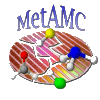
There is a clear demand from the industry for continuous measurement and control of airborne molecular contamination (AMC), since more detailed information on AMCs is needed for optimization of microfabrication processes, especially when migrating to new techniques with smaller scale objectives. Chemicals used in the manufacturing process are the primary AMC sources. The formation and behaviour of AMCs are still largely unknown, mainly due to the lack of measurement methods that are sensitive enough to detect these molecules at (sub) parts per billion levels in real time. To overcome this, a three year project of 2.9 Mio € was started in May 2013 within the ![]() European Metrology Research Programme. The project encompasses a multitude of national metrology institutes and other stakeholders.
European Metrology Research Programme. The project encompasses a multitude of national metrology institutes and other stakeholders.
Recent progress in laser-based quantitative molecular spectroscopy has brought the detection limits of typical contaminants to a level that meets the industrial need for AMC measurements. The high adsorptivity of the common AMCs combined with their very low concentration make sampling, transportation and generation of calibration gases challenging. Thus the three main goals of the project were:
The results of the project are available to the European stakeholders especially in the semiconductor industry, in microfabrication, and for manufacturers of optical instrumentation. In addition to developing new measurement instruments and services, the project provides good practice guides on detection and generation of AMCs (see ![]() below) and organized workshops and training courses.
below) and organized workshops and training courses.
Further reading: